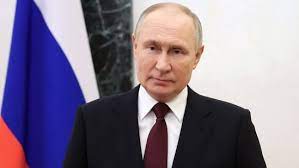President Vladimir Putin announced on Wednesday that Russia has successfully tested its Poseidon nuclear-powered super torpedo, a weapon military analysts warn could devastate coastal regions by triggering massive radioactive ocean waves.
The announcement comes shortly after U.S. President Donald Trump intensified his rhetoric toward Moscow. In recent weeks, Russia conducted a Burevestnik nuclear cruise missile test on October 21 and nuclear launch drills on October 22, underscoring Moscow’s efforts to display its military might.
Poseidon: A Nuclear-Powered “Doomsday” Weapon
Few technical details about the Poseidon have been officially disclosed, but it is described as a nuclear-capable underwater drone-torpedo hybrid, designed for long-range, autonomous missions.
Speaking at a Moscow hospital while meeting soldiers wounded in the Ukraine war, Putin said the test was a major milestone.
“For the first time, we managed not only to launch it from a carrier submarine but also to activate the nuclear power unit, which operated for a certain period,” Putin stated.
He added that “there is nothing like this” in the world and claimed the Poseidon cannot be intercepted. Analysts estimate the torpedo has a range of up to 10,000 km and travels at about 185 km/h.
Renewed Nuclear Signaling Amid Western Pressure
According to observers, the recent Burevestnik and Poseidon tests are part of Russia’s message to the West — that it will not succumb to pressure over the war in Ukraine.
For Trump, who recently dismissed Russia as a “paper tiger” for its prolonged war in Ukraine, the tests serve as a reminder of Moscow’s enduring nuclear capabilities and its intent to remain a key player in global arms control negotiations.
Poseidon and the Modern Nuclear Arms Race
The Poseidon, known by its NATO codename “Kanyon,” symbolizes what Putin describes as a new global nuclear arms race among the U.S., Russia, and China.
Reports in Russian media suggest the weapon is 20 meters long, 1.8 meters wide, and weighs around 100 tonnes. Arms control experts believe it may carry a two-megaton nuclear warhead and be powered by a liquid-metal-cooled reactor—breaking traditional nuclear deterrence norms.
Putin boasted that Poseidon’s power surpasses even Russia’s Sarmat intercontinental missile (SS-X-29 “Satan II”).
He has long justified developing such advanced systems as a response to U.S. withdrawal from the 1972 Anti-Ballistic Missile Treaty in 2001 and NATO’s continued eastern expansion.
Following the Burevestnik test, Trump urged Putin to focus on ending the war in Ukraine rather than testing nuclear-powered weapons.

